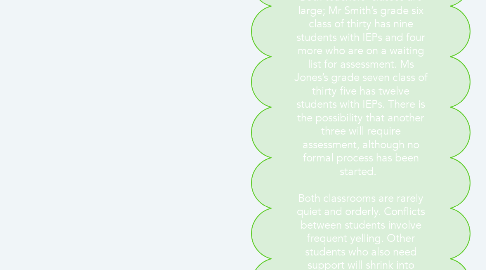Mr Smith and Ms Jones are first-year teachers at a mid-sized suburban middle school in Ontario. The average class size is thirty-three students, and there are two EAs to attend to the fifteen classes there on a daily basis. To support their students with exceptionalities, the school administration has large-scale assessments completed (such as DRAs). To support their faculty, the administration enables PD opportunities with a subject-specific focus. Both Ms Jones and Mr Smith have attended one PD seminar already this year; Ms Jones attended one about science for grades six to eight and Mr Smith attended one about mathematics teaching strategies for the middle years. The DRAs and other large-scale assessments of students that are included in the administrative budget are used to inform faculty about student needs. However, the school administration finds it difficult to analyse data from assessments and often just adds the identification to the IEP without consulting with all teachers about the students. Mr Smith and Ms Jones often collaborate after school to discuss their days and to plan for the coming day’s events. They both agree that the school’s efforts to provide support for their students based on these formal assessments are not reaching their intended potential. Both teachers’ classes are large; Mr Smith’s grade six class of thirty has nine students with IEPs and four more who are on a waiting list for assessment. Ms Jones’s grade seven class of thirty five has twelve students with IEPs. There is the possibility that another three will require assessment, although no formal process has been started. Both classrooms are rarely quiet and orderly. Conflicts between students involve frequent yelling. Other students who also need support will shrink into themselves because of the overwhelming environment caused by the conflicting student personalities. As such, they are frequently overlooked as the teachers try to manage the behaviours of the students who are acting out. All of these students, as a whole, struggle to find success on assessments of any sort. Ms Jones struggles to provide appropriate supports for three of her identified students, who are frequently off task. For example, when she is leading a math class, at least one of these boys will often get up from his desk a few times and walk around the classroom, ostensibly on his way to use the pencil sharpener. This disrupts the other students, and Ms Jones ends up spending a large portion of the instructional time trying to corral them and encourage him back to his desk. In Mr Smith’s class, there is one student who struggles to retain any information from lessons or discussions. While her verbal communication skills are strong, when Mr Smith is talking with her she will nod and give non-verbal cues of listening, but then will ask, “Wait, what?” as soon as the instructions or statement is finished. She has a very difficult time staying organized, forgetting to start assignments. Trying to complete work in class is virtually impossible for her as she becomes very easily overwhelmed and breaks down. In contrast, she also lashes out at those around her who are trying to help her. Administration, while aware of the needs of these and all of the identified students, chalk up difficulties in the Ms Jones’s and Mr Smith’s classes to poor classroom management on the part of the teachers, and so does not provide support to develop their skills in this area. Both teachers are feeling overwhelmed and unsure as to whether they can manage to continue at this school after this year.
by Letitia Coles



